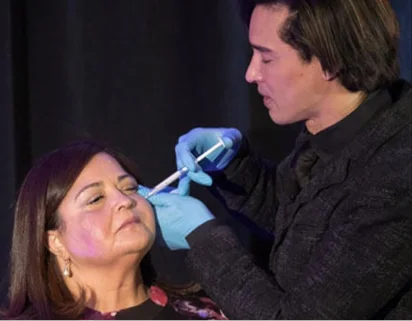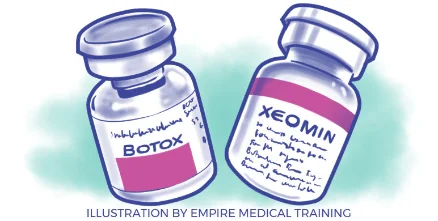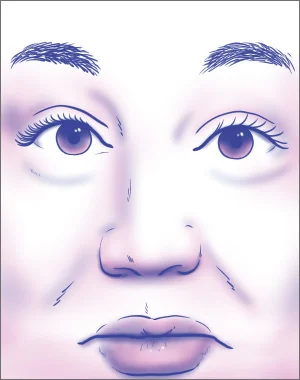Botox® Vs Xeomin®
Neurotoxins | February 20, 2021

Botox® Vs Xeomin
Entry made by
Empire Medical Training
Xeomin® (incobotulinum toxin type A) is a major competitor of Botox® (onabotulinum toxin type A), the first approved cosmetic treatment derived from botulinum toxin type A.
The distinctions between Botox and Xeomin are significant from providers’ and patients’ perspectives and should not be minimized. However, the two medications
have much in common, starting with the obvious fact that they are both derived from the same potent neurotoxin. Despite important differences in molecular composition, indications, storage protocols, cost, and more, we should
not minimize their similarities. Moreover, the choice to use Botox over Xeomin (or vice versa) in situations where either is indicated often comes down to patient and provider preference.
That being said, Xeomin and
Botox are by no means interchangeable or identical. It is vital for physicians and aestheticians trained in the cosmetic and/or therapeutic use of Botox and other botulinum toxin-derived medications to understand the differences between them.

Botox Vs. Xeomin: Background and Indications Botox and Xeomin have both been approved for clinical use in the United States since before 2010. Both are derived from botulinum toxin A and are approved for the treatment of multiple cosmetic and musculoskeletal
conditions. They are competitors: Botox is manufactured by Allergan; Xeomin is produced by Merz.
Botox: History and Indications Botox (onabotulinum toxin A) is the “original” botulinum toxin
A (BoNT-A) treatment and remains the most popular with patients and practitioners around the world.
Approved by the FDA for human testing in 1978 as “oculinum,” the medication received its first formal FDA approvals
in 1989 for the treatment of strabismus and blepharospasm, two relatively common conditions involving the eye muscles. In 1991, its official name was changed to onabotulinumtoxin-A.
During the early 21st century, the
FDA approved Botox for treatment of a variety of cosmetic and musculoskeletal conditions. Among others, these included:
- Cervical dystonia (2000)
- Glabellar lines (2002)
- Chronic migraine (2012)
- Lateral canthal rhytids (2013)
- Overactive bladder (2015)
- Forehead rhytids (2017)
Xeomin: History and Indications
Xeomin (incobotulinum toxin A) is a U.S.-made treatment free of the complexing proteins found in other botulinum toxin preparations (including Botox). Branded outside the United States as Bocouture®, incobotulinum toxin A is in widespread therapeutic
use globally. In 2010, Xeomin was approved by the FDA for the treatment of cervical dystonia.
Today, Xeomin is a principal competitor of Botox. Following FDA approval for treatment of cervical
dystonia, it received approval for treatment of muscle spasticity, blepharospasm and hemifacial spasm, and glabellar complex. Its range of FDA-approved indications is narrower than Botox’s; however, like Botox, it can be used
safely and effectively for a broader mix of off-label indications.
Statistics, Treatment & Benefits
Both Botox and Xeomin are produced from the same strain of C. botulinum (Hall) using the same isolation methods. Their respective pH values are identical (+/- 7) but they use different excipients (humin albumin with sodium chloride and human albumin with sucrose, respectively) and formulation methods (vacuum drying and lyophilization, respectively).
Statistics
Botox and Xeomin have different complex molecular weights (kDa): 900 and 200-300, respectively. For providers familiar with Botox, this is a slight disadvantage of Xeomin over the newer competitor Jeuveau (prabotulinum toxin A), which has a molecular weight identical to Botox and therefore easier to dose-calculate. Both Botox and Xeomin come in 50/100 unit packages and both are comparably priced on a per-unit basis.
Treatment and Benefits
Botox and Xeomin are both delivered via intramuscular injection in accordance with treatment-specific procedures. At comparable dilution, Xeomin may diffuse farther, making it appropriate for larger muscle groups and treatment areas.
Xeomin injections may take longer than Botox injections for effects to become apparent (three to as many as seven days
versus two to five days) but this is somewhat patient- and context-dependent. Xeomin and Botox remain effective for comparable lengths of time, depending on dosing and treatment region.
One notable advantage of Xeomin
is ease of storage. Unlike Botox and most other botulinum A toxin competitors, Xeomin does not need to be refrigerated before use. This makes it easier for low-overhead providers to use and for other providers to trial its
use in clinical settings.
Another notable advantage of Xeomin is the absence of protein additives. While more study needs to be done, this may reduce the risk of patients developing antibodies against the medication
and render it more effective than Botox and other BoNT-A treatments for repeat use.
Contraindications and Exclusion Criteria
Botox and Xeomin are both regarded by the FDA and other national health authorities as safe, effective treatments for a variety of indicated conditions. However, like all medications, they are not appropriate in all scenarios. Botulinum treatments are not appropriate for any patients deemed “at risk” due to underlying chronic medical conditions or use of medications that may interact unfavorably with the toxin.
When to Exclude Candidates for Botox or Xeomin Treatment
Patients should be excluded from treatment with Botox or Xeomin if they meet one or more of the following criteria:
- Any “at risk” condition that requires medical monitoring, such as myasthenia gravis or Lambert-Eaton syndrome
- Certain chronic underlying health conditions, such as diabetes (Type 1 or 2), rheumatoid arthritis, or congestive heart failure
- Known allergy or sensitivity to any component of the medication, including botulinum toxin itself or albumin, sucrose, or lactose
- Marked facial asymmetry, ptosis, or other anatomical defects
- Known history of facial palsy
- Skin infection at or near the planned treatment site
- Known pregnancy, planned pregnancy, or breastfeeding
- Anticoagulants like warfarin
- Aminoglycoside antibiotics
- Muscle relaxers and other classes of drugs that may increase the toxin’s potency
- Certain classes of drugs that interfere with the action of the toxin on the muscles or neutralize the toxin itself

Possible Risks and Side Effects of Xeomin and Botox
Both Xeomin and Botox present known risks and potential side effects for patients. These include systemic side effects such as difficulty breathing and loss of bladder control as well as localized side effects such as redness, swelling, and eyelid drooping.
While the absolute incidence of BoNT-A side effects is low and serious complications are very rare, providers must be aware of these risks and discuss them with patients prior to treatment.
Known side effects of Botox and Xeomin include allergic reactions at the injection site, such as:
- Swelling
- Itching
- Redness
Botox Vs. Xeomin: Which Should You Choose?
Botox and Xeomin have many subtle differences that make each more or less appropriate in different settings, but we should not lose sight of the fact that both are regarded as safe, effective treatments for a variety of cosmetic and musculoskeletal issues. Both have earned a place in the procedural repertoire of any well-rounded physician or aesthetician trained to treat the conditions for which they are indicated. In the end, each provider’s preference is just that — a matter of preference.


